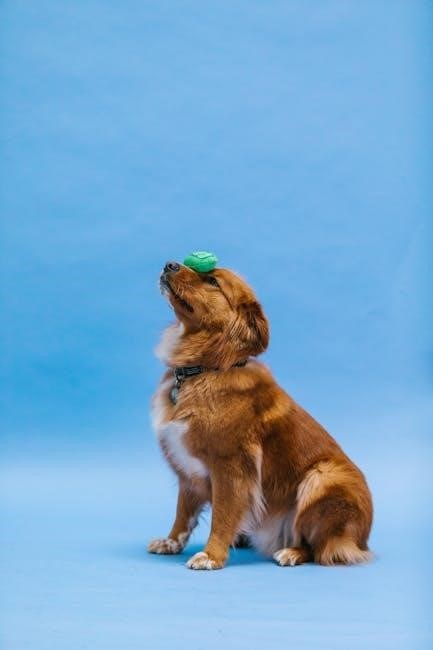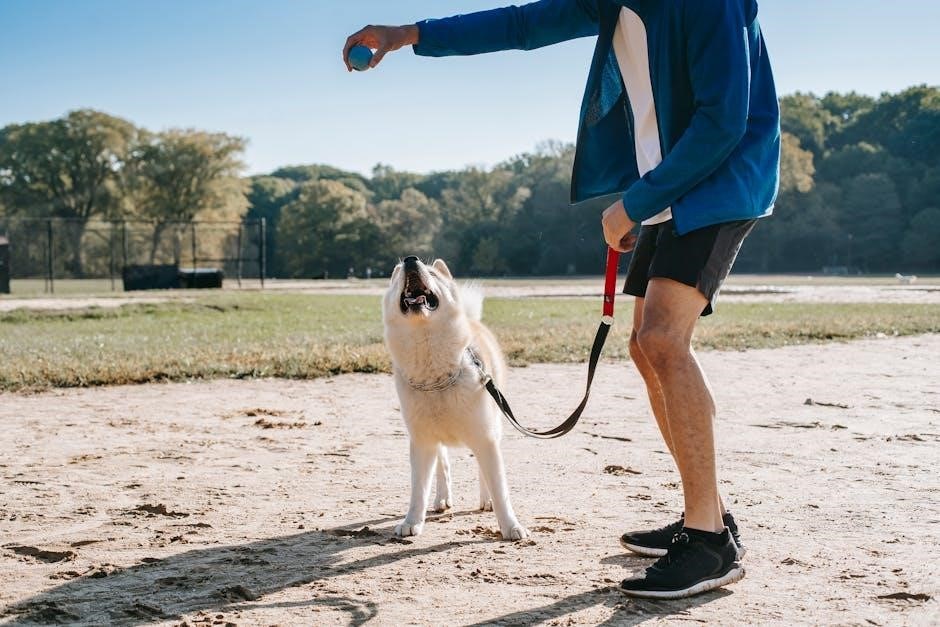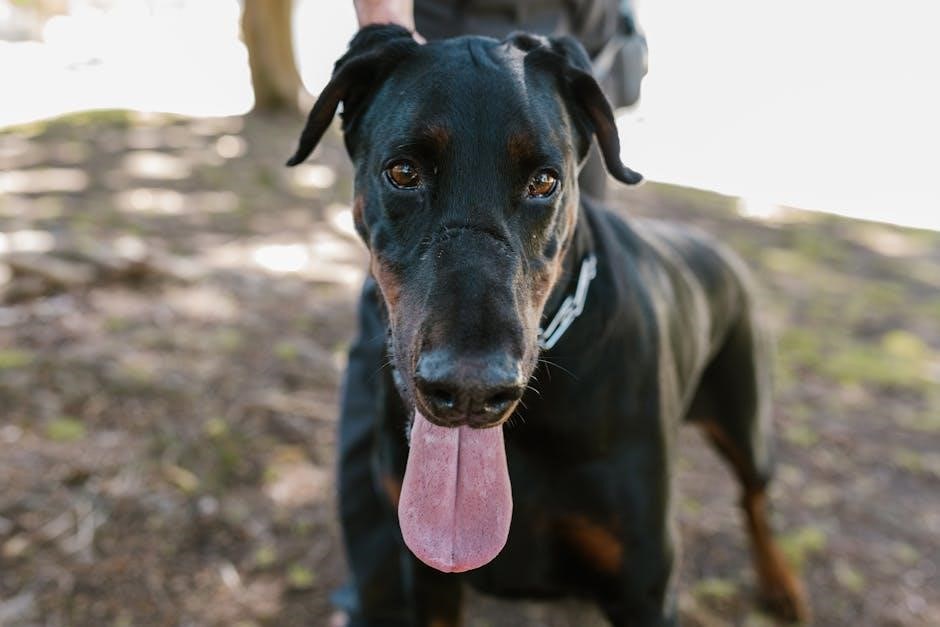Dog training commands are essential for establishing clear communication and fostering a strong bond between dogs and their owners. Basic commands like Sit, Stay, and Come provide a foundation for more complex behaviors, ensuring better behavior management and safety. Positive reinforcement techniques, such as rewards and praise, motivate dogs to learn and respond effectively. A concise list of commands simplifies training, especially in high-pressure situations. Understanding these commands helps owners guide their dogs confidently, creating a more harmonious relationship.

Importance of Basic Commands
Basic dog training commands are the cornerstone of effective communication between dogs and their owners. Commands like “Sit,” “Stay,” and “Come” provide a foundation for understanding and obedience, ensuring safety and clarity in various situations. These commands help establish boundaries and routines, which are crucial for a dog’s emotional and behavioral well-being. By mastering basic commands, dogs learn to focus and respond reliably, even in distracting environments. This foundation also enables owners to introduce more complex behaviors and commands later in the training process. Positive reinforcement techniques, such as treats and praise, motivate dogs to learn and respond positively to these commands. A well-trained dog is less likely to engage in unwanted behaviors and is better equipped to handle real-life challenges, such as encountering strangers or navigating public spaces; Ultimately, basic commands foster trust, respect, and a stronger bond between dogs and their owners, making training a rewarding experience for both parties.
Sit

The “Sit” command is one of the most fundamental dog training commands and is often the first behavior taught to a dog. It involves the dog lowering its bottom to the ground while maintaining a calm and controlled posture. Teaching a dog to sit is beneficial for everyday interactions, such as before meals, during walks, or in social situations. To train this command, owners typically use a lure-reward method, holding a treat above the dog’s head and moving it backwards towards their tail. As the dog follows the treat with their nose, they naturally lower into a sitting position. Once the dog is in the correct position, the owner gives the command “Sit” and rewards them with the treat and praise. Consistency and repetition are key to reinforcing this behavior. Over time, the dog will learn to associate the command with the action, making it a reliable and useful skill in various scenarios. This command also serves as a building block for more advanced training, such as “Stay” or “Down,” and helps establish a strong foundation for further learning.
Stay
The “Stay” command is a crucial behavior that builds on the “Sit” command, teaching a dog to remain in a stationary position, either sitting or lying down, without moving or getting distracted. This command is essential for maintaining control in various situations, such as during walks, in public places, or when preparing meals. To train “Stay,” start by having the dog sit, then take a few steps back while giving the command. Reward the dog for remaining in place. Gradually increase the distance and duration over time. Consistency is key, as the dog needs to understand that “Stay” means remaining still until released. If the dog moves, calmly guide them back to the correct position and try again. Avoid distractions initially and introduce them slowly to help the dog generalize the behavior. Positive reinforcement, such as treats and praise, encourages the dog to comply. “Stay” is not only useful for practical purposes but also strengthens the bond between the dog and owner, fostering trust and discipline. Over time, the dog will learn to remain calm and focused, even in challenging environments.
Come

The “Come” command is one of the most essential and powerful commands in dog training, ensuring your dog returns to you promptly, no matter the situation. It is a lifesaver, particularly in emergencies or when your dog is off-leash. To train this command, start in a quiet, controlled environment with minimal distractions. Call your dog by their name, say “Come,” and use a hand signal, such as extending your arm straight out and then pulling it back toward your body. When your dog responds, reward them with treats, praise, or play to reinforce the behavior. Gradually increase distractions and distance to help your dog generalize the command. Consistency is key—use the same verbal cue and hand signal every time to avoid confusion. Over time, your dog will learn to associate “Come” with positive outcomes, making them more likely to respond eagerly. This command strengthens your bond and provides peace of mind, knowing your dog will return to you reliably in any situation.
Lie Down
The “Lie Down” command teaches your dog to lower themselves into a resting position, which is useful for calm behavior and can help in various situations. To train this command, start by having your dog sit. Hold a treat near their chest and slowly move it downward toward the ground while saying “Lie Down.” As your dog follows the treat with their nose, they will naturally lie down. Once they are in the correct position, give them the treat and praise them. Repeat this process until your dog learns the association. Gradually phase out the treats, using the verbal command and a hand signal, such as sweeping your hand downward. Consistency and patience are key to mastering this command. Over time, your dog will understand that “Lie Down” means it’s time to relax, which can be especially helpful in calming your dog in stressful environments or during quiet times at home. This command enhances your dog’s ability to respond to cues and strengthens your communication.
Leave It
The “Leave It” command is a valuable tool to teach your dog self-control and prevent unwanted behavior. It instructs your dog to disengage from an object, food, or situation, ensuring their safety and reducing potential conflicts. To train this command, place a treat in front of your dog and say “Leave It.” If they try to take the treat, cover it with your hand and say “No.” When they stop trying to take it, praise them and offer a different treat as a reward; Gradually increase the difficulty by using more tempting items. Consistency is key to helping your dog understand the command. Once mastered, “Leave It” can be used in various situations, such as preventing your dog from eating trash or approaching dangerous objects. This command not only improves obedience but also strengthens trust between you and your dog, making it an essential part of their training.
Intermediate Commands
Intermediate commands build on basic obedience, helping your dog develop more complex skills and stronger focus. These commands are essential for refining your dog’s behavior and preparing them for advanced training. One key intermediate command is “Down,” which instructs your dog to lie down from a sitting position. This can be taught by luring your dog with a treat near their chest and slowly moving it downward. Another important command is “Stay Close,” which teaches your dog to remain near you without wandering off, enhancing their ability to follow directions in distracting environments.
“Heel” is another intermediate command that instructs your dog to walk beside you calmly, without pulling on the leash. This command is crucial for maintaining control during walks and in public spaces. Additionally, “Drop It” teaches your dog to release an object they’re holding, preventing unwanted behaviors like resource guarding. These commands require patience, consistency, and positive reinforcement to ensure your dog masters them effectively.
Down
The “Down” command is a fundamental intermediate skill that teaches your dog to lie down from a sitting or standing position. This command is useful for calming your dog in public spaces or during training sessions. To introduce “Down,” start by having your dog sit, then use a treat to lure them into the down position by moving your hand downward and forward. As they follow the treat with their nose, they will naturally lie down. Once they are in the correct position, say “Down” and reward them with the treat and praise.
Consistency is key when teaching “Down.” Use a clear hand signal, such as sweeping your hand downward, to help your dog associate the gesture with the command. Gradually phase out the treats as your dog becomes more familiar with the command. Practice this in various locations and contexts to ensure your dog understands it fully. Over time, “Down” will become a reliable command, helping you maintain control and reinforce good behavior.
Stay Close
The “Stay Close” command is an intermediate-level instruction that teaches your dog to remain near you without wandering off; This command is particularly useful in public spaces, such as parks or busy streets, where you want your dog to stay within a certain proximity. Unlike the “Stay” command, which often involves your dog remaining in a stationary position, “Stay Close” allows your dog to move freely while maintaining a connection to you.
To teach “Stay Close,” start by having your dog on a leash and using a verbal cue like “Stay Close” or a hand signal, such as holding your palm toward them. Reward your dog with treats or praise when they remain near you. Gradually increase the distance and distractions to help your dog understand the command in various situations. Over time, your dog will learn to associate the command with staying close, even without a leash. This command not only enhances your dog’s obedience but also strengthens your bond and ensures their safety in public environments.
Heel
The “Heel” command is an essential intermediate-level instruction that teaches your dog to walk beside you calmly and attentively, without pulling on the leash. This command is particularly useful for maintaining control during walks, especially in crowded or distracting environments. When your dog is “heeling,” they should stay close to your left side, with their head held high and their attention focused on you.
To teach the “Heel” command, start by having your dog on a short leash and use a verbal cue like “Heel” or a hand signal, such as holding your palm downward near your thigh. Reward your dog with treats or praise when they walk beside you without pulling. Gradually introduce distractions and longer walks to reinforce the behavior. Consistency is key, as this command requires your dog to remain focused and responsive to your guidance. Over time, your dog will learn to associate “Heel” with walking politely by your side, making outings more enjoyable for both of you.

Drop It
The “Drop It” command is an intermediate-level instruction that teaches your dog to release an object they are holding onto. This command is crucial for preventing unwanted behaviors, such as chewing on inappropriate items or refusing to let go of something dangerous. By mastering “Drop It,” you can ensure your dog’s safety and maintain control over their actions.
To teach “Drop It,” start by offering your dog a treat in exchange for the object they are holding. Use the verbal cue “Drop It” and encourage them to release the item. Gradually introduce more challenging scenarios, such as using different types of objects or increasing distractions. Consistency and patience are key, as this command requires your dog to trust your guidance and understand the value of letting go. Over time, your dog will learn to respond promptly to “Drop It,” making it easier to manage situations where they pick up something they shouldn’t.
Advanced Commands
Advanced commands are designed for dogs that have already mastered basic and intermediate instructions, offering a higher level of challenge and complexity. These commands enhance your dog’s ability to understand and respond to more intricate directions, fostering greater communication and trust between you and your pet.
Examples of advanced commands include “Find,” where your dog learns to locate specific items, and “Stay Close,” which ensures your dog remains near you even in distracting environments. These commands require consistent practice and reinforcement, often involving hand signals and verbal cues. By introducing advanced commands, you can further refine your dog’s behavior, enabling them to perform tasks with precision and reliability.
Advanced training not only strengthens the bond between you and your dog but also prepares them for real-world situations, ensuring they can adapt to various challenges confidently. With patience and dedication, your dog can excel in these advanced commands, showcasing their intelligence and trainability.

Leave a Reply
You must be logged in to post a comment.